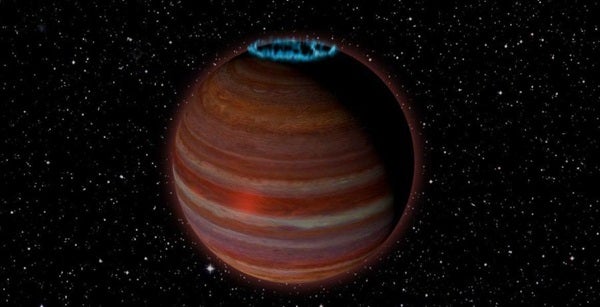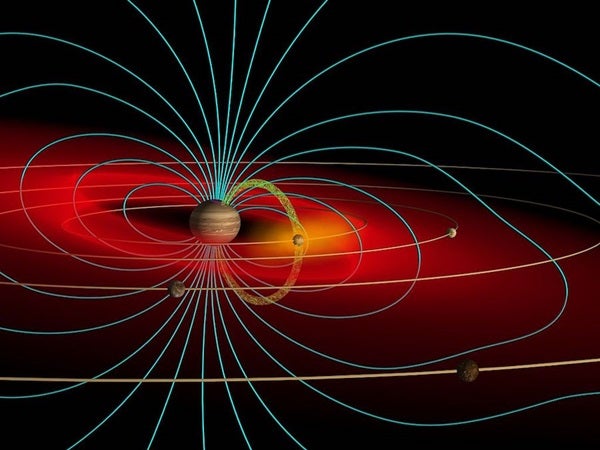Key Takeaways:
- A rogue planet dubbed SIMP, lacking a parent star, showcases remarkable magnetic power and stunning auroras, challenging our understanding of planetary dynamics.
- SIMP’s discovery provides a unique opportunity to study magnetic processes in both stars and planets, offering insights into celestial phenomena beyond our solar system.
- Its colossal size, magnetic field millions of times stronger than Earth’s, and blazing surface temperature make SIMP a fascinating celestial anomaly.
- The detection of SIMP through radio emissions hints at a new method for identifying exoplanets, including those wandering independently without orbiting a star.
- By unraveling the mysteries of SIMP’s magnetic field and auroras, scientists hope to gain deeper insights into exoplanetary dynamics and potentially uncover more rogue planets in the cosmos.

A peculiar wandering planet, detached from any star, drifts within the Milky Way, merely 20 light-years distant from the Sun. Recently disclosed in The Astrophysical Journal, this enigmatic nomadic entity possesses an extraordinarily potent magnetic field, surpassing that of Earth by approximately 4 million times. Remarkably, this exoplanet also showcases magnificent auroras, surpassing the splendor of our own northern lights.
These fresh observations, facilitated by the National Science Foundation’s Karl G. Jansky Very Large Array (VLA), mark not only the primary radio observations of a planetary-scale entity beyond our solar system but also signify the inaugural instance researchers have gauged the magnetic field of such a celestial body.
Examining SIMP
The eccentric and unattached entity, succinctly labelled SIMP J01365663+0933473 (hereafter referred to as SIMP for brevity), was initially detected in 2016. Initially classified as a brown dwarf, an entity too substantial to be a planet yet too diminutive to be a star, subsequent studies in the previous year revealed that SIMP, with a mass equivalent to 12.7 times that of Jupiter and a radius 1.2 times greater, qualifies as a planet—albeit an immense one.
Melodie Kao of Arizona State University, who spearheaded the recent study on SIMP, expressed, “This object straddles the boundary between a planet and a brown dwarf, or ‘failed star,’ and presents surprises that could potentially enhance our comprehension of magnetic phenomena on both stellar bodies and planets.”
For a planet, SIMP boasts a rather elevated temperature: exceeding 1,500 degrees Fahrenheit (825 Celsius). To contextualize, Venus, the hottest planet in our solar system, maintains an average temperature of approximately 875 F (470 C), while the Sun, a relatively modest and cool star, registers a surface temperature of about 10,000 F (5,500 C). However, it’s noteworthy that Venus derives most of its heat from the Sun. In contrast, since solitary SIMP does not orbit a star, its warmth must stem from its initial formation approximately 200 million years ago. Consequently, this planetary behemoth will gradually dissipate its heat over time.
Unmatched Magnetism
According to the latest study, SIMP not only boasts colossal proportions by planetary standards but also harbors a magnetic field millions of times more potent than Earth’s. While this magnetic field contributes to SIMP’s spectacular light displays, the auroras manifest differently compared to those on Earth.
Jupiter possesses the most formidable magnetic field in the solar system, nearly 20,000 times stronger than Earth’s, giving rise to remarkably luminous auroras. These phenomena occur as electrically charged particles accelerate along the planet’s magnetic field lines, colliding with atoms in Jupiter’s upper atmosphere at speeds of approximately 3,000 miles (5,000 kilometers) per second.
On Earth, a similar process yields the northern and southern lights; however, the charged particles responsible for Earth’s auroras primarily originate from the Sun in the form of solar wind. Conversely, on Jupiter, these particles predominantly emanate from its moon Io rather than the solar wind. Given that SIMP lacks a star bombarding it with solar wind akin to Earth, researchers posit that SIMP’s auroras may resemble those of Jupiter’s, suggesting the potential presence of a moon.
Magnetic Revelation

To summarise: SIMP appears to be a colossal, magnetic exoplanet adrift without a star, possibly accompanied by a moon, generating splendid auroras while traversing the Milky Way.
Impressive indeed. But how does this intriguing discovery contribute to astronomers’ understanding of the universe?
Kao elaborated, “This particular entity is enthralling because studying its magnetic dynamo mechanisms can furnish us with fresh insights into how similar mechanisms operate in extrasolar planets. We believe these mechanisms can operate not only in brown dwarfs but also in both gas giant and terrestrial planets.”
In essence, SIMP promises to enhance astronomers’ comprehension of magnetic field generation in exoplanets. But there’s more!
“Detecting SIMP J01365663+0933473 with the VLA through its auroral radio emission also suggests that we may have a novel method for detecting exoplanets, including the elusive rogue ones not orbiting a parent star,” remarked co-author Gregg Hallinan of Caltech.
Hence, SIMP emerges not only as an exceptionally captivating entity in its own right but also as a gateway to future revelations concerning exoplanetary magnetic fields and auroras, facilitating the quest for exoplanets that prefer solitude.


